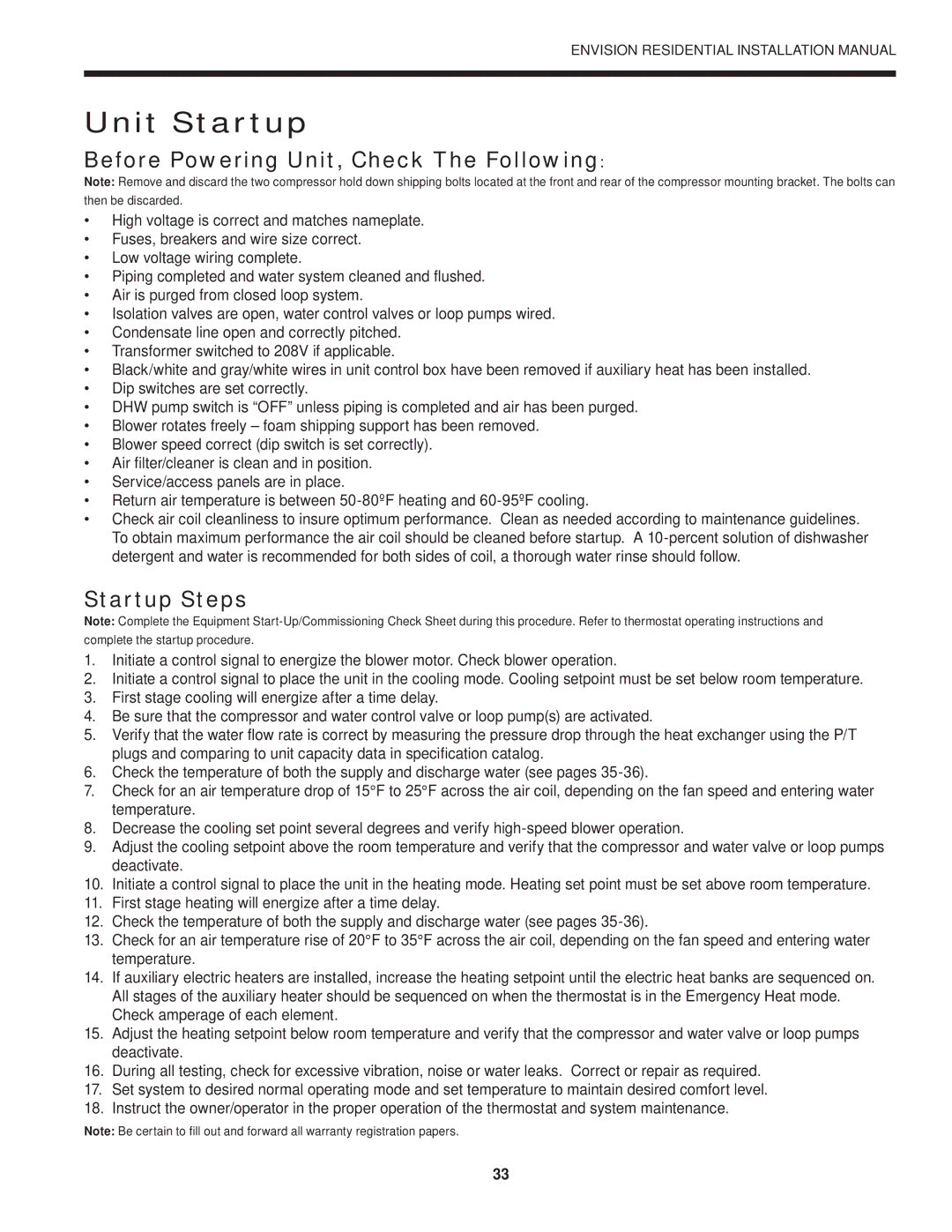ENVISION RESIDENTIAL INSTALLATION MANUAL
Unit Startup
Before Powering Unit, Check The Following:
Note: Remove and discard the two compressor hold down shipping bolts located at the front and rear of the compressor mounting bracket. The bolts can then be discarded.
•High voltage is correct and matches nameplate.
•Fuses, breakers and wire size correct.
•Low voltage wiring complete.
•Piping completed and water system cleaned and flushed.
•Air is purged from closed loop system.
•Isolation valves are open, water control valves or loop pumps wired.
•Condensate line open and correctly pitched.
•Transformer switched to 208V if applicable.
•Black/white and gray/white wires in unit control box have been removed if auxiliary heat has been installed.
•Dip switches are set correctly.
•DHW pump switch is “OFF” unless piping is completed and air has been purged.
•Blower rotates freely – foam shipping support has been removed.
•Blower speed correct (dip switch is set correctly).
•Air filter/cleaner is clean and in position.
•Service/access panels are in place.
•Return air temperature is between
•Check air coil cleanliness to insure optimum performance. Clean as needed according to maintenance guidelines. To obtain maximum performance the air coil should be cleaned before startup. A
Startup Steps
Note: Complete the Equipment
1.Initiate a control signal to energize the blower motor. Check blower operation.
2.Initiate a control signal to place the unit in the cooling mode. Cooling setpoint must be set below room temperature.
3.First stage cooling will energize after a time delay.
4.Be sure that the compressor and water control valve or loop pump(s) are activated.
5.Verify that the water flow rate is correct by measuring the pressure drop through the heat exchanger using the P/T plugs and comparing to unit capacity data in specification catalog.
6.Check the temperature of both the supply and discharge water (see pages
7.Check for an air temperature drop of 15°F to 25°F across the air coil, depending on the fan speed and entering water temperature.
8.Decrease the cooling set point several degrees and verify
9.Adjust the cooling setpoint above the room temperature and verify that the compressor and water valve or loop pumps deactivate.
10.Initiate a control signal to place the unit in the heating mode. Heating set point must be set above room temperature.
11.First stage heating will energize after a time delay.
12.Check the temperature of both the supply and discharge water (see pages
13.Check for an air temperature rise of 20°F to 35°F across the air coil, depending on the fan speed and entering water temperature.
14.If auxiliary electric heaters are installed, increase the heating setpoint until the electric heat banks are sequenced on. All stages of the auxiliary heater should be sequenced on when the thermostat is in the Emergency Heat mode. Check amperage of each element.
15.Adjust the heating setpoint below room temperature and verify that the compressor and water valve or loop pumps deactivate.
16.During all testing, check for excessive vibration, noise or water leaks. Correct or repair as required.
17.Set system to desired normal operating mode and set temperature to maintain desired comfort level.
18.Instruct the owner/operator in the proper operation of the thermostat and system maintenance.
Note: Be certain to fill out and forward all warranty registration papers.
33
